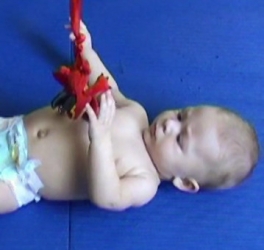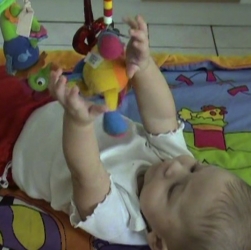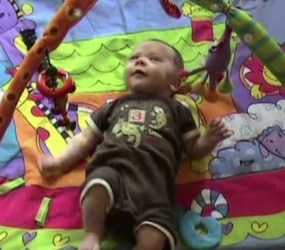Author Pam Versfeld MSc (Physiotherapy)
A play mat (play gym) with places for suspending toys provides a wonderful environment for infants to practice their looking, reaching, grasping and finger movements. The opportunity for repeated practice of these actions is especially important for infants who are at risk for later attention and fine motor difficulties, including preemie infants, Down syndrome, developmental delay and infants who generally are less active and are not motivated to move.
Choosing the right toys for the play mat
Most infants show more interest in some toys than others. You may need to experiment with different toys to find out which ones attract their interest.
Small brightly colored objects that shine when they move are often a good choice for very young infants. Red toys are good for catching an infant's attention.


Small soft toys that are easy to grasp with one hand will often encourage an infant to reach out and try to grasp. A string of plastic links also work well.

Bigger toys with tags, long ears and arms and legs that can be grasped work well for infants who are starting to grasp and use the fingers to explore an object.

Infants often respond well to a toy with a face.

This tensegrity ball was a favorite with my grandchildren.

A process of trial an error to find the best place to position the toys
Before you place the infant on the play mat, it is useful to spend some time experimenting with different toys suspended in different positions to find out what works best for the infant, and will depend on age and reaching abilities.
Let the infant lie on a firm flat surface. Suspend a toy so that it catches the infant's attention and is within easy reaching distance.
The best position depends on the infant's age and abilities. For younger infants and infants with developmental delay who still tend to hold their heads turned to one side, the best place may be slightly to the left or right of the midline so that the toy is in her field of vision.


From 2-3 months typically developing infants are able to hold their heads in the midline and start to reach for toys with both hands. Once the infant has learned to hold the head steady in the midline, the best place is often directly over the chest so that the infant needs to lift the hands upwards and forwards to reach the toy.

Take time to observe the infant's responses
- Does she spend time looking at the toy?
- Does she reach for the toy?
- Jiggle the toy to make it move - does she look at the movement?
Sometimes you can encourage an infant to reach for a toy if you position it so that she knocks it with her hand when moving her arms spontaneously. The movement of the toy usually catches the infant's attention.
If the infant does not lift the hand to reach for a toy
Infants whose spontaneous movements are slow or infrequent, who do not use their hands to explore or find it difficult to lift the arms up may need a different approach.
If this is the case, the best approach is to suspend a small soft toy with legs and arms so that it touches the infant's hand. A toy with a gentle bell is good because the sound will often catch the infant's visual attention.
The next step is to get the infant to look at her hand and the toy. Move the toy so that it tickles the hand. Move the string so that the toy swings a little and the bell rings.
- Do not expect an immediate response. Given time the infant will usually respond and start to bat at the toy with the hand or move the fingers to explore the toy.
If the infant seems to loose interest in a toy, try another one and see what happens. Remember to be patient and give the infant plenty of time to respond.
Once the infant has learnt to play with a toy that is close at hand, suspend the toy so that she needs to move the hand to reach it.
Provide some postural support if necessary
Successful reaching depends on the infant being able to hold the head and trunk steady. For infants with poor postural control it may be necessary to provide some support. The easiest way to do this is to create a nest with a soft rolled up blanket. A duvet or soft pillow can also be used to create a nest.

Ready, steady, lets play on the play mat
Once you have a good idea of what the infant can, and likes, to do, it is time to let him/her lie on the play mat and hang one or two toys within easy reach.

Observe you infant for a few minutes. Does he look at the toys? Does he reach out to touch a toy. Jiggle the toy a little to catch his attention.
If the infant does not reach for the toy, try moving it closer to his hand so that it is easy to reach or try another toy.
- It may help to create a bit of excitement to get the infant kicking and moving the arms. Make sure that the toy is the path of the moving hand so that it is batted and starts to move.
You can hang the toy on a piece of sewing elastic - then the infant can grab the toy and pull it to the mouth for inspection.
Take care not to overstimulate the infant
Very young infants can easily be overstimulated when they are in a situation where there is too much to look at or too many moving toys. If the infant becomes a little frantic and starts kicking vigorously it probably means that he is overstimulated and having difficulty disengaging his attention.
Two video clips to illustrate how two 8 week old infants play
This series of video clips illustrates the increasing control of hand function (reach, grasp and manipulation) infants achieve over the first 3-4 months.
They also show how, from an early age, infants will spend time exploring their ability to interact with toys when given the opportunity in an environment that suits their abilities and interests.
Will 8 weeks on play mat
At 8 weeks Will spends time looking at the toys, and from time to time contacts a toy as he waves his hands around. There are only 3 toys, but because he tends to move a lot the toys are swinging wildly and very soon he becomes overwhelmed and distressed.

Lily at 8 weeks CA
This video of Lily nicely illustrates the importance of allowing the infant enough time to discover her ability to reach for, and interact with, the suspended toys. You will also see that Lily's upper limb actions are still influenced by the position of her head.

More information
Development of Hand Function Home Page
Perspectives
- Attention is the magic ingredient for learning new hand (fine motor) skills
- A research based guide to observing infant object exploration
- Foundation manual behaviors birth - 5 months
- How infants use their hands to grow their brains (On the SfA Infant and Toddler Developmental Gym website)
For subscribers
See the full set of video clips here